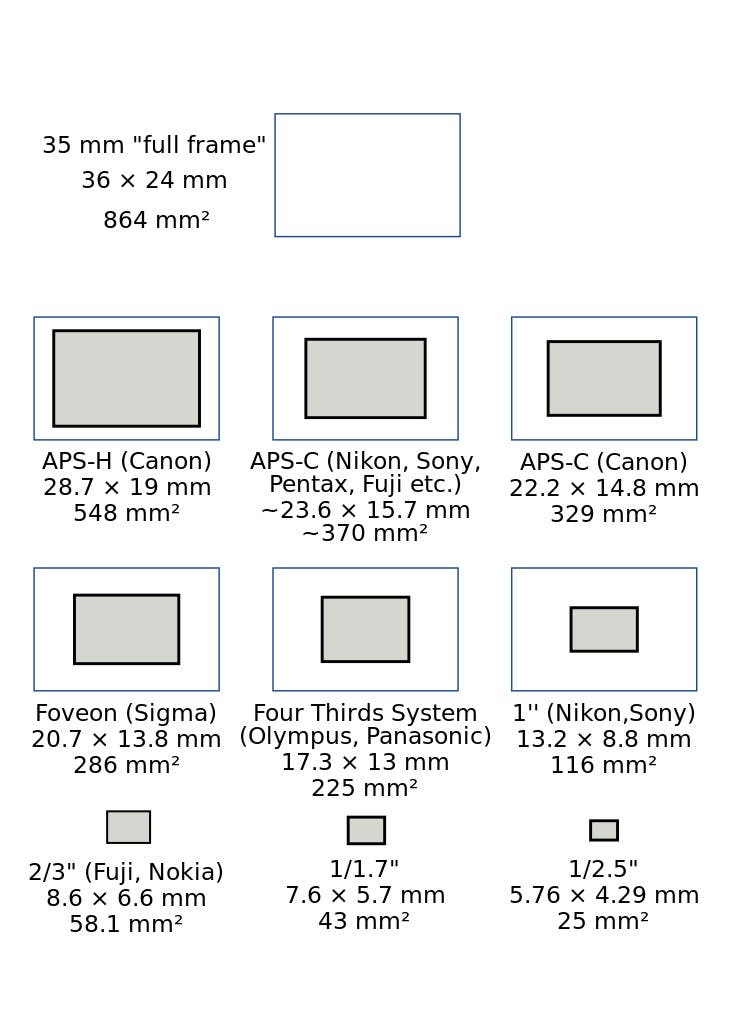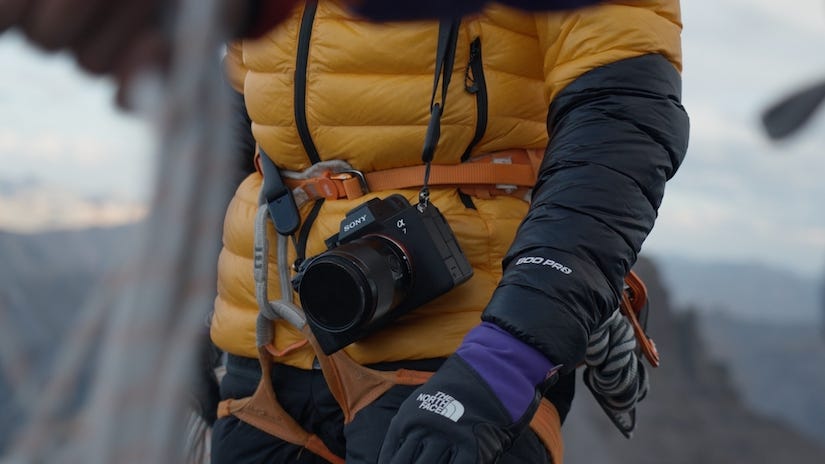Should I Buy A Ull Frame Camera?
Why practice and so many acme pros and discriminating shooters choose cameras with 24x36mm sensors? Because a full frame camera gives them benefits and an edge, both in terms of image quality and artistic control. To understand exactly how this works, you lot've got to wrap your head around 2 basic ideas: pixel size and pixel density, that is, the number of pixels per square millimeter. Here'southward how each 1 affects image quality.
What is a full frame photographic camera?
A full frame camera is a digital camera that has a sensor that is equal to the size of 35mm film, or 36x24mm. Full frame cameras provide the largest sensor y'all tin buy in a consumer camera. Typically, mid to professional-level mirrorless or DSLR cameras are full frame cameras.
A total frame sensor allows for more than calorie-free and data to get into the photographic camera, which increases quality and sharpness and provides greater dynamic range. While there are college quality sensor types out there, like medium format cameras, many professionals prefer the total-frame format.
Diagram of the Most Common Sensor Types:

Pixel Power: The Benefits of a Full-Frame Digital Camera
1. Full-frame cameras have bigger, better pixels
The larger the sensor, the larger each pixel volition be for a sensor of whatsoever given megapixel (MP) rating. Retrieve of a pixel as a ii-dimensional prototype chemical element or epitome capture bespeak. Larger pixels can capture more color information and likewise capture incoming light with greater efficiency and less dissonance than smaller pixels. This is the chief reason full-frame sensors can deliver improve functioning at college ISO settings than so-chosen crop sensors. They can also capture a greater dynamic range, and differentiate finer color variations within a given hue. All these characteristics enhance the accuracy, realism and vibrancy of the captured image.
two. Full-frame cameras tin deliver higher resolution
Full-frame sensors can also be configured to provide higher MP ratings and greater resolution than smaller sensors. This enhances the sensor's power to capture fine detail. Increasing the number of pixels on a total-frame sensor does make each individual pixel smaller. Merely these pixels are still large enough to retain the large sensor advantages of high prototype quality, extended dynamic range, etc. The manufacturer determines the precise residue between high ISO performance and high resolution largely based on the needs of end users.
A archetype example: The Sony Alpha a7S 3, which has a total-frame 12.1MP CMOS sensor, and a elevation ISO of 409600, is aimed primarily at low-calorie-free shooters and videographers. Meanwhile, the broad-spectrum Sony Alpha a7R IV, has an ultra-high-res, full-frame 62.5MP CMOS sensor and a top ISO of "but" 102400.

3. Total-frame cameras provide enhanced depth-of-field control
Full-frame cameras require longer focal-length lenses to cover the larger 24 x36mm format at whatever given coverage bending, compared to smaller-sensor cameras. For example, 50mm, 35mm, and 25mm lenses are normal lenses on full-frame-, APS-C-, and Micro Iv Thirds-format cameras respectively. As a result, full-frame lenses of equivalent coverage provide a shallower depth-of-field at any given discontinuity, so long as the images existence compared accept the same field of view (framing). This shallower depth of field is particularly noticeable at apertures of f/two.viii and wider, and makes it easier to achieve pleasing pictorial results in portraits or scenes where the sharply rendered chief field of study "pops" off the soft groundwork or foreground.
4. Total-frame cameras accept your broad-angles covered
An incidental reward of full-frame digital cameras is that broad-angle lenses designed for 35mm film cameras retain their full wide angles of view when used in your full-frame DSLR or mirrorless camera. Example: Mount an old transmission-focus 24mm f/ii.8 Nikkor on your new total-frame (FX-format) Nikon D5 and it'll cover the full 24mm field; mountain it on a APS-C (DX-format) Nikon D500, and it'll only embrace a 36mm semi-wide field due to the 1.5x crop gene. On the flip side, crop-sensor cameras tin can transform your trusty vintage 50mm f/i.4normal lens into a cool wide-aperture moderate telephoto, or extend the effective achieve of your telephoto zoom—ii good reasons to hang onto that compatible sub-full-frame trunk rather than merchandise it in.

v. Total-frame cameras allow you lot output oversize images
Since full-frame sensors capture more than data at every pixel point, they evangelize huge RAW paradigm files that can be printed out or digitally projected in large exhibition and gallery sizes such as 24 10 36 or 40 x 60 inches without visually compromising image quality and detail, even when they're viewed close up. Photographers that specialize in shooting images for billboards and giant photomurals ofttimes become even larger, opting for medium- and large-format digital capture. However, most photographers that make big prints consider their full-frame cameras to be the perfect solution.
6.Total-frame images are radically cropped
Cropping is one of the prime creative tools in photography. It'southward not always possible to compose perfectly at the moment of exposure, and many images are enhanced past cropping out distracting details or by bringing out dynamic elements. It'southward a lot easier to crop images shot with a total frame sensor without compromising epitome quality or increasing visual dissonance, because y'all start out with more information and item to brainstorm with. The difference is peculiarly noticeable in radically cropped images where the final prototype represents l% or less of the prototype captured past the sensor.
APS-C vs full frame camera: What'south the difference?
So what's the difference betwixt APS-C cameras and total frame cameras? The deviation lies in the size of their sensor. Full frame cameras have a sensor that is 36mmx24mm, based on the traditional 35mm moving picture format. APS-C or Avant-garde Photograph Arrangement type-C format cameras accept a sensor that is one.5 times smaller, at 25.1mm x 16.7mm.
Photographing with a smaller sensor photographic camera lowers the amount of light and information that gets into the camera. This, in turn, decreases epitome quality and dynamic range. If you're wanting to photo with professional full frame lenses on an APS-C camera, there will be a ane.5x ingather factor on the focal length. This is thank you to the smaller sensor size in the APS-C camera, which can limit how broad you tin can shoot.
Benefits of a Full-Frame Camera
These six real-globe advantages are first-class reasons for choosing a full-frame-digital camera. Just there are also compelling reasons why an APS-C- or Micro Iv Thirds-format camera might be a better option for you.
In general, full frame cameras, specially DSLRs, are larger, heavier, and more expensive than their smaller-format counterparts. And, through the magic of avant-garde epitome processing software and sensor design, leading APS-C-format cameras like the Nikon Z50, Fujifilm 10-T4, and Sony Blastoff a6600, and Micro Four thirds cameras similar the Olympus OM-D Due east-M1 Marking 3, Panasonic Lumix GH6, and Olympus OM-D E-M1X tin evangelize pro-caliber performance. Merely if you really need that "extra edge," full-frame is a not bad manner to go.
When is information technology fourth dimension to upgrade to a full frame camera?
Just put, if you're wanting to significantly increment the quality and resolution of your images, you'll desire to upgrade to a full frame photographic camera. Full frame cameras provide ameliorate low low-cal performance, increased sharpness, and greater dynamic range.
Full frame cameras also allow yous to work with professional person-level lenses, without the ane.5x crop factor. Any professional will tell y'all that quality glass is a game changer and is what takes your images to the adjacent level.
If you're wanting to take that side by side stride and improve as a lensman, or even make it a full-time career, investing and upgrading to a full frame camera is a must.
Source: https://www.adorama.com/alc/6-reasons-why-you-should-buy-a-full-frame-digital-camera/
Posted by: mcmanusthintwit.blogspot.com


0 Response to "Should I Buy A Ull Frame Camera?"
Post a Comment